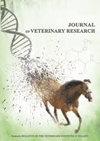肠病毒E感染牛外周血单个核细胞。对发病机制的影响?
IF 1.3
3区 农林科学
Q2 VETERINARY SCIENCES
引用次数: 0
摘要
肠病毒E (EV-E)是一种常见的牛流行性病毒。然而,人们对其与牛免疫细胞的潜在相互作用知之甚少。材料与方法测定牛外周血单个核细胞(PBMCs)的ev - e容许性。细胞接种后测定细胞外病毒的感染效价,用反转录定量PCR法测定细胞内病毒RNA水平。采用甲基噻唑基溴化四唑还原法观察EV-E对细胞活力和增殖反应的影响,采用流式细胞术检测主要淋巴细胞亚群百分比和血液吞噬细胞氧化爆发活性,ELISA检测促炎细胞因子分泌。结果肠病毒E能有效感染牛pbmc。最高感染剂量的EV-E降低细胞活力和t细胞增殖。所有试验剂量的病毒均能抑制高反应的脂多糖B细胞的增殖,并刺激白细胞介素1β、白细胞介素6和肿瘤坏死因子α的分泌。结论EV-E与牛免疫细胞的相互作用可能提示了病毒的逃逸机制。感染这种病毒也有可能使机体易受继发性感染,尤其是细菌感染。本文章由计算机程序翻译,如有差异,请以英文原文为准。
Enterovirus E infects bovine peripheral blood mononuclear cells. Implications for pathogenesis?
Abstract Introduction Enterovirus E (EV-E) is a common viral pathogen endemic in cattle worldwide. Little is known, however, about its potential interactions with bovine immune cells. Material and Methods The EV-E-permissiveness of bovine peripheral blood mononuclear cells (PBMCs) was evaluated. The infectious titres of extracellular virus were measured and the intracellular viral RNA levels were determined by reverse transcription quantitative PCR after cell inoculation. The effects of EV-E on cell viability and proliferative response were investigated with a methyl thiazolyl tetrazolium bromide reduction assay, the percentages of main lymphocyte subsets and oxidative burst activity of blood phagocytes were determined with flow cytometry, and pro-inflammatory cytokine secretion was measured with an ELISA. Results Enterovirus E productively infected bovine PBMCs. The highest infectious dose of EV-E decreased cell viability and T-cell proliferation. All of the tested doses of virus inhibited the proliferation of high responding to lipopolysaccharide B cells and stimulated the secretion of interleukin 1β, interleukin 6 and tumour necrosis factor α pro-inflammatory cytokines. Conclusion Interactions of EV-E with bovine immune cells may indicate potential evasion mechanisms of the virus. There is also a risk that an infection with this virus can predispose the organism to secondary infections, especially bacterial ones.
求助全文
通过发布文献求助,成功后即可免费获取论文全文。
去求助
来源期刊

Journal of Veterinary Research
Veterinary-General Veterinary
CiteScore
0.90
自引率
5.60%
发文量
58
审稿时长
18 weeks
期刊介绍:
Journal of Veterinary Research (formerly Bulletin of the Veterinary Institute in Pulawy) is a quarterly that publishes original papers, review articles and short communications on bacteriology, virology, parasitology, immunology, molecular biology, pathology, toxicology, pharmacology, and biochemistry. The main emphasis is, however, on infectious diseases of animals, food safety and public health, and clinical sciences.
 求助内容:
求助内容: 应助结果提醒方式:
应助结果提醒方式:


